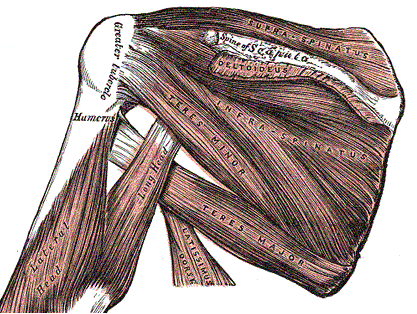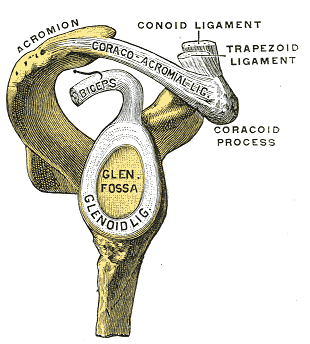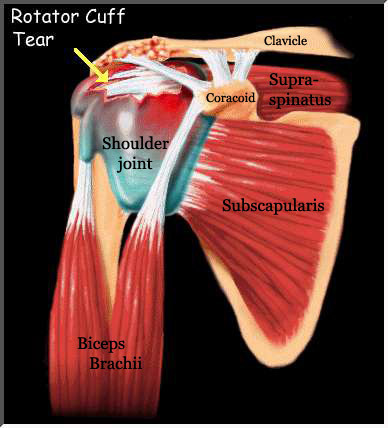Torn Rotator Cuff Muscles and Impingement Syndrome
What Is Rotator Cuff ?
The rotator cuff is a group of four muscles that encircle the shoulder joint. It provides a flexible support to the bones that form the shoulder joint (arm bone, scapula and clavicle) , without restricting shoulder range of motion in any way. They are four muscles, namely subscapularis, supraspinatus, infraspinatus and teres minor, that form the rotator cuff (Picture 1). These muscles rotate the arm inwards or outwards, hence the name – rotator cuff. The tendons of these muscles are merged together, forming a complete ring that is attached to the bones near the shoulder joint.

Picture 1: Rotator cuff muscles from behind
(source: Wikimedia)
Shoulder Anatomy
The shoulder joint (Picture 2) is a highly mobile, ball and socket joint between the humerus (arm bone) and the scapula (shoulder blade bone). The humerus has a rounded head, which fits into the cup-like cavity of the scapula, known as glenoid (Picture 3).
Picture 2: Shoulder joint
(source: Wikimedia)
Increased mobility of the shoulder joint is because of the glenoid being small and shallow compared to the humeral head. However, this comes at the cost of stability of the shoulder, which is in part compensated by the rotator cuff.
The scapula has two bony projections – the acromion, which attaches to the clavicle (collar bone), and the coracoid, which is a beak-like projection to which the biceps muscle is attached. These projections form an arch above the shoulder joint called the coraco-acromial arch (Picture 3).

Picture 3: Coraco-acromial arch
(source: Wikimedia)
The movement of the rotator cuff beneath this arch is aided by the presence of the sub-acromial bursa, a bag of fat preventing friction between the muscles and the bones. A narrow coraco-acromial arch or inflammation of the bursa are frequent reasons for development of tears in the upper part of the rotator cuff.
What Is Rotator Cuff Tear?
Torn rotator cuff is a partial or full thickness tear of one or more shoulder muscles forming the rotator cuff, resulting in a shoulder pain, stiffness and weakness.
How Does Rotator Cuff Tear Occur ?
The rotator cuff is not always torn by athletic activity, as one may assume. There are several mechanisms, which can lead to a torn rotator cuff, even in a person with a sedentary lifestyle. The tearing of the rotator cuff occurs slowly over a period of time rather than by a single traumatic event. However, a single large trauma to an already weak muscle can also cause a tear.
The entrapment of the rotator cuff in a narrow coraco-acromial arch leads to progressive injury of the supraspinatus muscle, which forms the upper part of the rotator cuff. The narrow coraco-acromial arch can be due to a hooked acromion process.
In elderly, a formation of a bony spur on the acromion can result in friction between the spur and supraspinatus muscle resulting in the muscle tear.
In sport, a single or repeating rotator cuff injury, usually affecting subscapularis muscle, mostly occurs during overhead throwing.

Picture 4: Rotator cuff tear in right shoulder, front view
(source: Chiro Org Images)
The absence of proper treatment can result in shoulder instability and arthritis of the shoulder joint. The rotator cuff pulls the bones of the shoulder joint together, thus enabling their coordinate movements. Tearing of the rotator cuff initially causes a spasm of the involved muscle resulting in a stiff shoulder joint; about a week later, when the muscles relax, the joint becomes lax. The abnormal motion between the joint surfaces of a lax joint resultsin an injury to the joint cartilage leading to a full blown arthritis.
Symptoms of Torn Rotator Cuff
Contrary to the common belief, rotator cuff tears are often an incidental finding in patients with a shoulder pain. They cause vague symptoms, like weakness in shoulder movements, which are often ignored. This is also because many of the rotator cuff movements are compensated by other muscles. A person with advanced tear of supraspinatus muscle often shrugs his shoulders during activities that require the arm to be lifted. This is an attempt to compensate the function of supraspinatus, which lifts the arm between 60-120 degrees (in torn rotator cuff, pain appears in this range of motion) – this is called a painful arc syndrome .
On and off pain and mild stiffness are a part of any joint injury. At this stage people often try to relieve symptoms with over the counter medications. Though, this works fine for most of the chronic painful shoulders, it does not help in a rotator cuff tear, which tend to progressively worsen. Shoulder pain can appear during daily activities, like brushing teeth, combing hair and so on. In advanced cases, the pain even occurs during sleep, especially while lying on the affected shoulder.
The joint stiffness in rotator cuff tears is only an attempt of muscles to prevent painful movements. Passive movements (when someone other moves your arm), especially after administration of a local anesthetic injection, are not restricted. This is a routine procedure to differ a torn rotator cuff from a frozen shoulder.
The other causes of shoulder pain, like rheumatoid arthritis, broken clavicle, or acromio-clavicular dislocation, are associated with swelling of the shoulder joint, which is never seen in rotator cuff tears, except in terminal stages of shoulder arthritis, which occurs in untreated tears over years.
Investigations
Early detection of rotator cuff tear is important to prevent serious damage of the shoulder joint.
- Magnetic resonance imaging (MRI) is the investigation of choice, as it clearly reveals the site and thickness of a tear, and the extent of cartilage and bone injury
- Plain X-rays are not useful for identifying rotator cuff tears, but are used to check for bony abnormalities, like hooked acromion, acromian spur and joint space widening.
- Ultrasound can detect rotator cuff tears but is not highly reliable so is used only for initial screening of larger tears; small tears are often missed.
- Arthrography is highly accurate in diagnosis but due to its invasive nature it is hardly used nowadays.
Treatment
Conservative Treatment
As long as the muscle strength is maintained, partial tears can be effectively managed conservatively for pain relief. Full thickness tears are not painful and hence treatment is frequently delayed by the patient, but eventually they require surgical repair. Sometimes, partial thickness tears are also treated surgically.
Conservative management consists of rest for a couple of weeks with specific restriction of activity that causes pain. Oral or injectable analgesics and anti-inflammatory medications help to relieve the pain and promote healing of the tissues. Progressive physical therapy with graded exercises helps to build up strength in the remaining muscle units and to add more muscle units to the injured muscles and restore the function of the rotator cuff.
Surgical Treatment
With an acromioplasty any bony spurs or excessive bone tissue in hooked acromion processes are removed. This is done with the help of an arthroscope (a viewing instrument), after making only a small incision in the shoulder. This not only heals quickly, but also reduces hospital stay and expenses.
Completion of partial tears to full thickness tears and their subsequent repair with sutures helps to reduce pain and return to normal activity after a couple of months of physical therapy.
Tendon transfers are important in old non-treated tears, in which scarring has shortened the muscles thus preventing re-joining their ends. Parts of other shoulder muscles are used to re-connect the torn muscles. This is a major procedure that requires an extensive re-training of the transferred muscles with physical therapy lasting for a couple of months.
Shoulder replacement surgery is the only option for the permanently damaged arthritic shoulder. The arthritic joint surfaces of the humerus and the glenoid cavity are sawed off, and metal surfaces are implanted over them. The procedure is costly but is often necessary in young athletes and others who want to continue with an active lifestyle. The operation is irreversible, meaning the original state of the shoulder can not be restored. In complications, like infection, displacement of the implant and so on, the operation has to be re-done, and sometimes the shoulder joint has to be fused (made immobile). Hence, a shoulder replacement is always a last resort option, and one has to take all the instructions given by the doctor very seriously.
What Is Rotator Cuff Impingement ?
Impingement means to collide against something. In the context of rotator cuff, impingement refers to collision of the rotator cuff with acromion (a part of the shoulder blade bone – scapula) and the head of the arm bone (humerus), as it passes through a narrow tunnel – the coraco-acromial arch.
How does Rotator Cuff Impingement Occur ?
Normally, the upper part of the rotator cuff, gets trapped in the coraco-acromial arch, when the arm is fully lifted up. However, there is just enough space, for to and fro movement of the rotator cuff. Sometimes the arch is narrowed further, by bony overgrowth, or an abnormal acromion process. In this case, the rotator cuff frequently hits on the acromion and the head of the arm bone, causing damage to the rotator cuff tendon. This is also seen with mild shoulder instability, because of the abnormal movement of the bones upon each other. It is more frequent in people using their arm in overhead activities, like swimming, throwing, and so on.
Symptoms of Impingement Syndrome
This syndrome frequently manifests with pain while lifting the arm upwards, which disappears when the arm is lifted upwards. The pain worsens with time, as more and more parts of the tendon are damaged due to repetitive overhead movements. Impingement syndrome is an important cause of supraspinatus tendinopathy and rotator cuff tear.
Treatment of Impingement Syndrome
The treatment of impingement syndrome consists of taking a break from overhead activities, along with analgesics and anti-inflammatory medications. Strengthening of the damaged rotator cuff with physical therapy helps to reinforce the stabilising function of the rotator cuff on the shoulder joint, which in turn decreases further damage.

